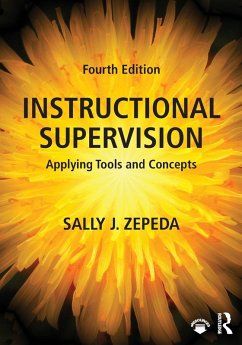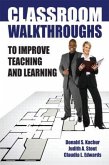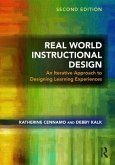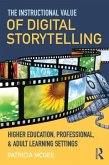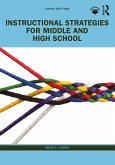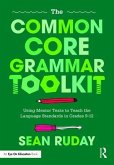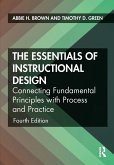- Broschiertes Buch
- Merkliste
- Auf die Merkliste
- Bewerten Bewerten
- Teilen
- Produkt teilen
- Produkterinnerung
- Produkterinnerung
This essential text for prospective school leaders enrolled in instructional supervision and evaluation courses provides the knowledge and practical tools to improve teacher effectiveness. Melding theory and practice, this book is a definitive guide to successful classroom observations, pre- and post-observation conferences, and approaches such as action research, peer coaching, and mentoring. The fourth edition of this text has been thoroughly updated to meet the needs of school leaders in today's educational climate. Features new to this edition include: Additional and updated tools to…mehr
Andere Kunden interessierten sich auch für
![Classroom Walkthroughs To Improve Teaching and Learning Classroom Walkthroughs To Improve Teaching and Learning]() Judy StoutClassroom Walkthroughs To Improve Teaching and Learning46,99 €
Judy StoutClassroom Walkthroughs To Improve Teaching and Learning46,99 €![Real World Instructional Design Real World Instructional Design]() Katherine Cennamo (Professor of Learning Sciences and TechnologiesReal World Instructional Design109,99 €
Katherine Cennamo (Professor of Learning Sciences and TechnologiesReal World Instructional Design109,99 €![The Instructional Value of Digital Storytelling The Instructional Value of Digital Storytelling]() Patricia McGee (USA University of Texas at San Antonio)The Instructional Value of Digital Storytelling64,99 €
Patricia McGee (USA University of Texas at San Antonio)The Instructional Value of Digital Storytelling64,99 €![Instructional Strategies for Middle and High School Instructional Strategies for Middle and High School]() Bruce E. LarsonInstructional Strategies for Middle and High School78,99 €
Bruce E. LarsonInstructional Strategies for Middle and High School78,99 €![The Common Core Grammar Toolkit The Common Core Grammar Toolkit]() Sean Ruday (USA Longwood University)The Common Core Grammar Toolkit40,99 €
Sean Ruday (USA Longwood University)The Common Core Grammar Toolkit40,99 €![The Essentials of Instructional Design The Essentials of Instructional Design]() Abbie H. Brown (USA East Carolina University)The Essentials of Instructional Design80,99 €
Abbie H. Brown (USA East Carolina University)The Essentials of Instructional Design80,99 €![Coaching in Education Coaching in Education]() Coaching in Education60,99 €
Coaching in Education60,99 €-
-
-
This essential text for prospective school leaders enrolled in instructional supervision and evaluation courses provides the knowledge and practical tools to improve teacher effectiveness. Melding theory and practice, this book is a definitive guide to successful classroom observations, pre- and post-observation conferences, and approaches such as action research, peer coaching, and mentoring. The fourth edition of this text has been thoroughly updated to meet the needs of school leaders in today's educational climate. Features new to this edition include: Additional and updated tools to support school leaders in conducting effective classroom observations and assessing teachers' professional learning needs; New case studies, suggested fieldwork, and extended reflections to outline practical applications for the strategies discussed; Suggested readings to supplement the information included in this book; Expanded discussions of professional learning communities and the topic of motivation; New chapters on teacher evaluation and instructional strategies that support personalization and learning technologies. This book offers strategies to work with teachers at all stages in their careers, laying a strong foundation for effective instructional supervision in PreK-12 schools. Many of the templates and tools in this book are also available as free eResource downloads from our website (www.routledge.com/9781138649347).
Hinweis: Dieser Artikel kann nur an eine deutsche Lieferadresse ausgeliefert werden.
Hinweis: Dieser Artikel kann nur an eine deutsche Lieferadresse ausgeliefert werden.
Produktdetails
- Produktdetails
- Verlag: Taylor & Francis Ltd
- 4 New edition
- Seitenzahl: 384
- Erscheinungstermin: 1. September 2016
- Englisch
- Abmessung: 254mm x 178mm x 21mm
- Gewicht: 728g
- ISBN-13: 9781138649347
- ISBN-10: 1138649341
- Artikelnr.: 45712281
- Herstellerkennzeichnung
- Libri GmbH
- Europaallee 1
- 36244 Bad Hersfeld
- gpsr@libri.de
- Verlag: Taylor & Francis Ltd
- 4 New edition
- Seitenzahl: 384
- Erscheinungstermin: 1. September 2016
- Englisch
- Abmessung: 254mm x 178mm x 21mm
- Gewicht: 728g
- ISBN-13: 9781138649347
- ISBN-10: 1138649341
- Artikelnr.: 45712281
- Herstellerkennzeichnung
- Libri GmbH
- Europaallee 1
- 36244 Bad Hersfeld
- gpsr@libri.de
Sally J. Zepeda is Professor of Educational Administration and Policy at the University of Georgia, USA.
Supplemental Downloads
About the Author
Acknowledgments
Introduction
1 Leadership Needed to Promote Supervision, Professional Development, and
Teacher
Evaluation That Makes a Difference
Introduction
Supervision, Professional Development, and Teacher Evaluation Are Not
Linear, Lockstep
Processes
Leadership Beliefs and Practices to Unify Processes
Coherence Needed for Instructional Supervision, Professional Development,
and Teacher
Evaluation
Accountability and High Stakes Challenges for Supervisors
Tool 1: Developing a Unified Vision for Supervision, Professional
Development, and
Teacher Evaluation
Summary
Suggested Activities
References
2 Instructional Supervision
Introducing Instructional Supervision
The Intents of Instructional Supervision
Differentiated Supervision
Developmental Supervision
Styles That Support Differentiated and Developmental Supervision
Summary
Suggested Activities
References
3 Teacher Evaluation
Introducing Teacher Evaluation
The Intents and Purposes of Teacher Evaluation
Formative and Summative Evaluation
Federal and State Influences on Teacher Evaluation
Teacher Evaluation Systems
Value-Added Measures
Summary
Suggested Activities
References
4 Job-Embedded Professional Development
Introducing Job-Embedded Professional Development
Status of Professional Development
Standards for Professional Development
Learning Communities-More than a Reform Strategy
Tool 2: Job-Embedded Learning: Finding Time for Professional Development
Tool 3: Planning for Professional Development
Tool 4: Identifying Professional Development Needs
Making the Connection Between Instructional Supervision, Professional
Development, and Job-Embedded Learning
Summary
Suggested Activities
References
5 Instruction and Learning Environments
Introducing Instruction and Learning Environments
Teacher Quality and Teacher Effectiveness
Effective Teachers
Accountability and Standards
Effective Instructional Practices
Inside Teacher Evaluation Frameworks
Observable Practices
Tool 5: Contextualizing Teaching and Learning-Getting to Observable
Practices
Personalized Learning Environments and Learning Technologies
Summary
Suggested Activities
References
6 Career Stages, Adult Learning, and Supervision
Introducing Career Stages, Adult Learning, and Supervision
Tool 6: Career Stages
Tool 7: Goal Setting, Tracking Faculty Goals, and Goal Attributes
Adult Learning
Supervision That Embraces the Adult Learner across Career Stages
Summary
Suggested Activities
References
7 Motivation and Supervisory Leadership
Introducing Motivation and Supervisory Leadership
Motivation Defined
Motivation Theories
Leadership and Motivation
Implications for Supervisors
Summary
Suggested Activities
References
8 Informal and Formal Classroom Observations
Introducing Informal and Formal Classroom Observations
Group Classroom Observations
Tool 8: Informal Classroom Observations
Tool 9: Guidelines for Informal Classroom Observations
Formal Classroom Observations
The Clinical Supervision Model and Its Components
Summary
Suggested Activities
References
9 The Pre-observation Conference
Introducing the Pre-observation Conference
Tool 10: Attributes of the Pre-observation Conference
Focus and the Pre-observation Conference
The Johari Window and the Pre-observation Conference
How to Prepare for the Classroom Observation
Summary
Suggested Activities
References
10 The Classroom Observation
Introducing the Classroom Observation
The Intents of Data Collection
Tool 11: Types of Data
Tool 12: Wide-Angle and Narrow-Angle Data Collection Techniques
Tips from the Field
Overview and Application of Observation Tools and Methods
Tool 13: Observation Guide Using Bloom's Taxonomy
Tool 14: Focus on Wait Time
Tool 15: Focus on Cause-and-Effect Data
Tool 16: Focus on Variety of Instructional Methods
Tool 17: Examining Teacher-Student Discussion with a Focus on How Student
Comments Are Incorporated into the Lesson
Tool 18: Selective Verbatim: Teacher's Verbal and Students' Physical and
Verbal Behaviors
Tool 19: Wide Angle: No Focus
Tool 20: Focus on Calling Patterns and Patterns of Interaction
Tool 21: Focus on Tracking Transition Patterns
Tool 22: Tracking the Beginning and Ending (Closure) of Class
Tool 23: Observing Cooperative Group Learning
Tool 24: Classroom Traffic
Summary
Suggested Activities
References
11 The Post-observation Conference
Introducing the Post-observation Conference
The Purposes of the Post-observation Conference
Lesson Reconstruction, Constructivism, and the Zone of Proximal Development
Preparing for the Post-observation Conference
Supervisory Approaches and the Post-observation Conference
Tool 25: Feedback, Trust, and the Johari Window Revisited
After the Post-Observation Conference, Then What?
Tool 26: Planning for Professional Growth
Summary
Suggested Activities
References
12 Mentoring and Induction
Introducing Mentoring and Induction
The Multifaceted and Complex Nature of Mentoring
Examining Qualities, Skills, and Functions of Mentors
Selecting, Training, and Assigning Mentors
Induction: Where Mentoring Matters Most
Formative Assistance: The Linkage to Supervision
Summary
Suggested Activities
References
13 Peer Coaching
Introducing Peer Coaching
Frame Peer Coaching
Phases of the Original Peer Coaching Model
Types of Coaching
Peer Coaching Includes Classroom Observations
Conditions for Successful Peer Coaching
Connecting Peer Coaching to Other Forms of Supervision
Summary
Suggested Activities
References
14 Action Research
Introducing Action Research
Action Research Defined
Models of Action Research
The Processes and Components of Action Research
Reflection
Connecting Action Research to Instructional Supervision
Summary
Suggested Activities
References
15 Portfolio Supervision
Introducing Portfolio Supervision
What is a Portfolio?
Extending Clinical Supervision through Portfolio Development
A Model of Portfolio Supervision
Essential Skills: Reflection, Goal Setting, and Decision Making
The Portfolio as a Framework to Extend Supervision
Summary
Suggested Activities
References
16 Confronting Marginal Teaching
Introducing Confronting Marginal Teaching
Marginal Teaching
Markers of Marginal Teacher Performance
Understanding the Difficulties Supervisors Encounter While Working with
Marginal Teachers
Confronting Marginal Teaching Practices
Working with Marginal Teachers
Tool 27: Formal Plan of Remediation
When All Else Fails
Summary
Suggested Activities
References
17 Coda for Instructional Supervision
References
Appendix: Classroom Observation Tools
Index
About the Author
Acknowledgments
Introduction
1 Leadership Needed to Promote Supervision, Professional Development, and
Teacher
Evaluation That Makes a Difference
Introduction
Supervision, Professional Development, and Teacher Evaluation Are Not
Linear, Lockstep
Processes
Leadership Beliefs and Practices to Unify Processes
Coherence Needed for Instructional Supervision, Professional Development,
and Teacher
Evaluation
Accountability and High Stakes Challenges for Supervisors
Tool 1: Developing a Unified Vision for Supervision, Professional
Development, and
Teacher Evaluation
Summary
Suggested Activities
References
2 Instructional Supervision
Introducing Instructional Supervision
The Intents of Instructional Supervision
Differentiated Supervision
Developmental Supervision
Styles That Support Differentiated and Developmental Supervision
Summary
Suggested Activities
References
3 Teacher Evaluation
Introducing Teacher Evaluation
The Intents and Purposes of Teacher Evaluation
Formative and Summative Evaluation
Federal and State Influences on Teacher Evaluation
Teacher Evaluation Systems
Value-Added Measures
Summary
Suggested Activities
References
4 Job-Embedded Professional Development
Introducing Job-Embedded Professional Development
Status of Professional Development
Standards for Professional Development
Learning Communities-More than a Reform Strategy
Tool 2: Job-Embedded Learning: Finding Time for Professional Development
Tool 3: Planning for Professional Development
Tool 4: Identifying Professional Development Needs
Making the Connection Between Instructional Supervision, Professional
Development, and Job-Embedded Learning
Summary
Suggested Activities
References
5 Instruction and Learning Environments
Introducing Instruction and Learning Environments
Teacher Quality and Teacher Effectiveness
Effective Teachers
Accountability and Standards
Effective Instructional Practices
Inside Teacher Evaluation Frameworks
Observable Practices
Tool 5: Contextualizing Teaching and Learning-Getting to Observable
Practices
Personalized Learning Environments and Learning Technologies
Summary
Suggested Activities
References
6 Career Stages, Adult Learning, and Supervision
Introducing Career Stages, Adult Learning, and Supervision
Tool 6: Career Stages
Tool 7: Goal Setting, Tracking Faculty Goals, and Goal Attributes
Adult Learning
Supervision That Embraces the Adult Learner across Career Stages
Summary
Suggested Activities
References
7 Motivation and Supervisory Leadership
Introducing Motivation and Supervisory Leadership
Motivation Defined
Motivation Theories
Leadership and Motivation
Implications for Supervisors
Summary
Suggested Activities
References
8 Informal and Formal Classroom Observations
Introducing Informal and Formal Classroom Observations
Group Classroom Observations
Tool 8: Informal Classroom Observations
Tool 9: Guidelines for Informal Classroom Observations
Formal Classroom Observations
The Clinical Supervision Model and Its Components
Summary
Suggested Activities
References
9 The Pre-observation Conference
Introducing the Pre-observation Conference
Tool 10: Attributes of the Pre-observation Conference
Focus and the Pre-observation Conference
The Johari Window and the Pre-observation Conference
How to Prepare for the Classroom Observation
Summary
Suggested Activities
References
10 The Classroom Observation
Introducing the Classroom Observation
The Intents of Data Collection
Tool 11: Types of Data
Tool 12: Wide-Angle and Narrow-Angle Data Collection Techniques
Tips from the Field
Overview and Application of Observation Tools and Methods
Tool 13: Observation Guide Using Bloom's Taxonomy
Tool 14: Focus on Wait Time
Tool 15: Focus on Cause-and-Effect Data
Tool 16: Focus on Variety of Instructional Methods
Tool 17: Examining Teacher-Student Discussion with a Focus on How Student
Comments Are Incorporated into the Lesson
Tool 18: Selective Verbatim: Teacher's Verbal and Students' Physical and
Verbal Behaviors
Tool 19: Wide Angle: No Focus
Tool 20: Focus on Calling Patterns and Patterns of Interaction
Tool 21: Focus on Tracking Transition Patterns
Tool 22: Tracking the Beginning and Ending (Closure) of Class
Tool 23: Observing Cooperative Group Learning
Tool 24: Classroom Traffic
Summary
Suggested Activities
References
11 The Post-observation Conference
Introducing the Post-observation Conference
The Purposes of the Post-observation Conference
Lesson Reconstruction, Constructivism, and the Zone of Proximal Development
Preparing for the Post-observation Conference
Supervisory Approaches and the Post-observation Conference
Tool 25: Feedback, Trust, and the Johari Window Revisited
After the Post-Observation Conference, Then What?
Tool 26: Planning for Professional Growth
Summary
Suggested Activities
References
12 Mentoring and Induction
Introducing Mentoring and Induction
The Multifaceted and Complex Nature of Mentoring
Examining Qualities, Skills, and Functions of Mentors
Selecting, Training, and Assigning Mentors
Induction: Where Mentoring Matters Most
Formative Assistance: The Linkage to Supervision
Summary
Suggested Activities
References
13 Peer Coaching
Introducing Peer Coaching
Frame Peer Coaching
Phases of the Original Peer Coaching Model
Types of Coaching
Peer Coaching Includes Classroom Observations
Conditions for Successful Peer Coaching
Connecting Peer Coaching to Other Forms of Supervision
Summary
Suggested Activities
References
14 Action Research
Introducing Action Research
Action Research Defined
Models of Action Research
The Processes and Components of Action Research
Reflection
Connecting Action Research to Instructional Supervision
Summary
Suggested Activities
References
15 Portfolio Supervision
Introducing Portfolio Supervision
What is a Portfolio?
Extending Clinical Supervision through Portfolio Development
A Model of Portfolio Supervision
Essential Skills: Reflection, Goal Setting, and Decision Making
The Portfolio as a Framework to Extend Supervision
Summary
Suggested Activities
References
16 Confronting Marginal Teaching
Introducing Confronting Marginal Teaching
Marginal Teaching
Markers of Marginal Teacher Performance
Understanding the Difficulties Supervisors Encounter While Working with
Marginal Teachers
Confronting Marginal Teaching Practices
Working with Marginal Teachers
Tool 27: Formal Plan of Remediation
When All Else Fails
Summary
Suggested Activities
References
17 Coda for Instructional Supervision
References
Appendix: Classroom Observation Tools
Index
Supplemental Downloads
About the Author
Acknowledgments
Introduction
1 Leadership Needed to Promote Supervision, Professional Development, and
Teacher
Evaluation That Makes a Difference
Introduction
Supervision, Professional Development, and Teacher Evaluation Are Not
Linear, Lockstep
Processes
Leadership Beliefs and Practices to Unify Processes
Coherence Needed for Instructional Supervision, Professional Development,
and Teacher
Evaluation
Accountability and High Stakes Challenges for Supervisors
Tool 1: Developing a Unified Vision for Supervision, Professional
Development, and
Teacher Evaluation
Summary
Suggested Activities
References
2 Instructional Supervision
Introducing Instructional Supervision
The Intents of Instructional Supervision
Differentiated Supervision
Developmental Supervision
Styles That Support Differentiated and Developmental Supervision
Summary
Suggested Activities
References
3 Teacher Evaluation
Introducing Teacher Evaluation
The Intents and Purposes of Teacher Evaluation
Formative and Summative Evaluation
Federal and State Influences on Teacher Evaluation
Teacher Evaluation Systems
Value-Added Measures
Summary
Suggested Activities
References
4 Job-Embedded Professional Development
Introducing Job-Embedded Professional Development
Status of Professional Development
Standards for Professional Development
Learning Communities-More than a Reform Strategy
Tool 2: Job-Embedded Learning: Finding Time for Professional Development
Tool 3: Planning for Professional Development
Tool 4: Identifying Professional Development Needs
Making the Connection Between Instructional Supervision, Professional
Development, and Job-Embedded Learning
Summary
Suggested Activities
References
5 Instruction and Learning Environments
Introducing Instruction and Learning Environments
Teacher Quality and Teacher Effectiveness
Effective Teachers
Accountability and Standards
Effective Instructional Practices
Inside Teacher Evaluation Frameworks
Observable Practices
Tool 5: Contextualizing Teaching and Learning-Getting to Observable
Practices
Personalized Learning Environments and Learning Technologies
Summary
Suggested Activities
References
6 Career Stages, Adult Learning, and Supervision
Introducing Career Stages, Adult Learning, and Supervision
Tool 6: Career Stages
Tool 7: Goal Setting, Tracking Faculty Goals, and Goal Attributes
Adult Learning
Supervision That Embraces the Adult Learner across Career Stages
Summary
Suggested Activities
References
7 Motivation and Supervisory Leadership
Introducing Motivation and Supervisory Leadership
Motivation Defined
Motivation Theories
Leadership and Motivation
Implications for Supervisors
Summary
Suggested Activities
References
8 Informal and Formal Classroom Observations
Introducing Informal and Formal Classroom Observations
Group Classroom Observations
Tool 8: Informal Classroom Observations
Tool 9: Guidelines for Informal Classroom Observations
Formal Classroom Observations
The Clinical Supervision Model and Its Components
Summary
Suggested Activities
References
9 The Pre-observation Conference
Introducing the Pre-observation Conference
Tool 10: Attributes of the Pre-observation Conference
Focus and the Pre-observation Conference
The Johari Window and the Pre-observation Conference
How to Prepare for the Classroom Observation
Summary
Suggested Activities
References
10 The Classroom Observation
Introducing the Classroom Observation
The Intents of Data Collection
Tool 11: Types of Data
Tool 12: Wide-Angle and Narrow-Angle Data Collection Techniques
Tips from the Field
Overview and Application of Observation Tools and Methods
Tool 13: Observation Guide Using Bloom's Taxonomy
Tool 14: Focus on Wait Time
Tool 15: Focus on Cause-and-Effect Data
Tool 16: Focus on Variety of Instructional Methods
Tool 17: Examining Teacher-Student Discussion with a Focus on How Student
Comments Are Incorporated into the Lesson
Tool 18: Selective Verbatim: Teacher's Verbal and Students' Physical and
Verbal Behaviors
Tool 19: Wide Angle: No Focus
Tool 20: Focus on Calling Patterns and Patterns of Interaction
Tool 21: Focus on Tracking Transition Patterns
Tool 22: Tracking the Beginning and Ending (Closure) of Class
Tool 23: Observing Cooperative Group Learning
Tool 24: Classroom Traffic
Summary
Suggested Activities
References
11 The Post-observation Conference
Introducing the Post-observation Conference
The Purposes of the Post-observation Conference
Lesson Reconstruction, Constructivism, and the Zone of Proximal Development
Preparing for the Post-observation Conference
Supervisory Approaches and the Post-observation Conference
Tool 25: Feedback, Trust, and the Johari Window Revisited
After the Post-Observation Conference, Then What?
Tool 26: Planning for Professional Growth
Summary
Suggested Activities
References
12 Mentoring and Induction
Introducing Mentoring and Induction
The Multifaceted and Complex Nature of Mentoring
Examining Qualities, Skills, and Functions of Mentors
Selecting, Training, and Assigning Mentors
Induction: Where Mentoring Matters Most
Formative Assistance: The Linkage to Supervision
Summary
Suggested Activities
References
13 Peer Coaching
Introducing Peer Coaching
Frame Peer Coaching
Phases of the Original Peer Coaching Model
Types of Coaching
Peer Coaching Includes Classroom Observations
Conditions for Successful Peer Coaching
Connecting Peer Coaching to Other Forms of Supervision
Summary
Suggested Activities
References
14 Action Research
Introducing Action Research
Action Research Defined
Models of Action Research
The Processes and Components of Action Research
Reflection
Connecting Action Research to Instructional Supervision
Summary
Suggested Activities
References
15 Portfolio Supervision
Introducing Portfolio Supervision
What is a Portfolio?
Extending Clinical Supervision through Portfolio Development
A Model of Portfolio Supervision
Essential Skills: Reflection, Goal Setting, and Decision Making
The Portfolio as a Framework to Extend Supervision
Summary
Suggested Activities
References
16 Confronting Marginal Teaching
Introducing Confronting Marginal Teaching
Marginal Teaching
Markers of Marginal Teacher Performance
Understanding the Difficulties Supervisors Encounter While Working with
Marginal Teachers
Confronting Marginal Teaching Practices
Working with Marginal Teachers
Tool 27: Formal Plan of Remediation
When All Else Fails
Summary
Suggested Activities
References
17 Coda for Instructional Supervision
References
Appendix: Classroom Observation Tools
Index
About the Author
Acknowledgments
Introduction
1 Leadership Needed to Promote Supervision, Professional Development, and
Teacher
Evaluation That Makes a Difference
Introduction
Supervision, Professional Development, and Teacher Evaluation Are Not
Linear, Lockstep
Processes
Leadership Beliefs and Practices to Unify Processes
Coherence Needed for Instructional Supervision, Professional Development,
and Teacher
Evaluation
Accountability and High Stakes Challenges for Supervisors
Tool 1: Developing a Unified Vision for Supervision, Professional
Development, and
Teacher Evaluation
Summary
Suggested Activities
References
2 Instructional Supervision
Introducing Instructional Supervision
The Intents of Instructional Supervision
Differentiated Supervision
Developmental Supervision
Styles That Support Differentiated and Developmental Supervision
Summary
Suggested Activities
References
3 Teacher Evaluation
Introducing Teacher Evaluation
The Intents and Purposes of Teacher Evaluation
Formative and Summative Evaluation
Federal and State Influences on Teacher Evaluation
Teacher Evaluation Systems
Value-Added Measures
Summary
Suggested Activities
References
4 Job-Embedded Professional Development
Introducing Job-Embedded Professional Development
Status of Professional Development
Standards for Professional Development
Learning Communities-More than a Reform Strategy
Tool 2: Job-Embedded Learning: Finding Time for Professional Development
Tool 3: Planning for Professional Development
Tool 4: Identifying Professional Development Needs
Making the Connection Between Instructional Supervision, Professional
Development, and Job-Embedded Learning
Summary
Suggested Activities
References
5 Instruction and Learning Environments
Introducing Instruction and Learning Environments
Teacher Quality and Teacher Effectiveness
Effective Teachers
Accountability and Standards
Effective Instructional Practices
Inside Teacher Evaluation Frameworks
Observable Practices
Tool 5: Contextualizing Teaching and Learning-Getting to Observable
Practices
Personalized Learning Environments and Learning Technologies
Summary
Suggested Activities
References
6 Career Stages, Adult Learning, and Supervision
Introducing Career Stages, Adult Learning, and Supervision
Tool 6: Career Stages
Tool 7: Goal Setting, Tracking Faculty Goals, and Goal Attributes
Adult Learning
Supervision That Embraces the Adult Learner across Career Stages
Summary
Suggested Activities
References
7 Motivation and Supervisory Leadership
Introducing Motivation and Supervisory Leadership
Motivation Defined
Motivation Theories
Leadership and Motivation
Implications for Supervisors
Summary
Suggested Activities
References
8 Informal and Formal Classroom Observations
Introducing Informal and Formal Classroom Observations
Group Classroom Observations
Tool 8: Informal Classroom Observations
Tool 9: Guidelines for Informal Classroom Observations
Formal Classroom Observations
The Clinical Supervision Model and Its Components
Summary
Suggested Activities
References
9 The Pre-observation Conference
Introducing the Pre-observation Conference
Tool 10: Attributes of the Pre-observation Conference
Focus and the Pre-observation Conference
The Johari Window and the Pre-observation Conference
How to Prepare for the Classroom Observation
Summary
Suggested Activities
References
10 The Classroom Observation
Introducing the Classroom Observation
The Intents of Data Collection
Tool 11: Types of Data
Tool 12: Wide-Angle and Narrow-Angle Data Collection Techniques
Tips from the Field
Overview and Application of Observation Tools and Methods
Tool 13: Observation Guide Using Bloom's Taxonomy
Tool 14: Focus on Wait Time
Tool 15: Focus on Cause-and-Effect Data
Tool 16: Focus on Variety of Instructional Methods
Tool 17: Examining Teacher-Student Discussion with a Focus on How Student
Comments Are Incorporated into the Lesson
Tool 18: Selective Verbatim: Teacher's Verbal and Students' Physical and
Verbal Behaviors
Tool 19: Wide Angle: No Focus
Tool 20: Focus on Calling Patterns and Patterns of Interaction
Tool 21: Focus on Tracking Transition Patterns
Tool 22: Tracking the Beginning and Ending (Closure) of Class
Tool 23: Observing Cooperative Group Learning
Tool 24: Classroom Traffic
Summary
Suggested Activities
References
11 The Post-observation Conference
Introducing the Post-observation Conference
The Purposes of the Post-observation Conference
Lesson Reconstruction, Constructivism, and the Zone of Proximal Development
Preparing for the Post-observation Conference
Supervisory Approaches and the Post-observation Conference
Tool 25: Feedback, Trust, and the Johari Window Revisited
After the Post-Observation Conference, Then What?
Tool 26: Planning for Professional Growth
Summary
Suggested Activities
References
12 Mentoring and Induction
Introducing Mentoring and Induction
The Multifaceted and Complex Nature of Mentoring
Examining Qualities, Skills, and Functions of Mentors
Selecting, Training, and Assigning Mentors
Induction: Where Mentoring Matters Most
Formative Assistance: The Linkage to Supervision
Summary
Suggested Activities
References
13 Peer Coaching
Introducing Peer Coaching
Frame Peer Coaching
Phases of the Original Peer Coaching Model
Types of Coaching
Peer Coaching Includes Classroom Observations
Conditions for Successful Peer Coaching
Connecting Peer Coaching to Other Forms of Supervision
Summary
Suggested Activities
References
14 Action Research
Introducing Action Research
Action Research Defined
Models of Action Research
The Processes and Components of Action Research
Reflection
Connecting Action Research to Instructional Supervision
Summary
Suggested Activities
References
15 Portfolio Supervision
Introducing Portfolio Supervision
What is a Portfolio?
Extending Clinical Supervision through Portfolio Development
A Model of Portfolio Supervision
Essential Skills: Reflection, Goal Setting, and Decision Making
The Portfolio as a Framework to Extend Supervision
Summary
Suggested Activities
References
16 Confronting Marginal Teaching
Introducing Confronting Marginal Teaching
Marginal Teaching
Markers of Marginal Teacher Performance
Understanding the Difficulties Supervisors Encounter While Working with
Marginal Teachers
Confronting Marginal Teaching Practices
Working with Marginal Teachers
Tool 27: Formal Plan of Remediation
When All Else Fails
Summary
Suggested Activities
References
17 Coda for Instructional Supervision
References
Appendix: Classroom Observation Tools
Index

